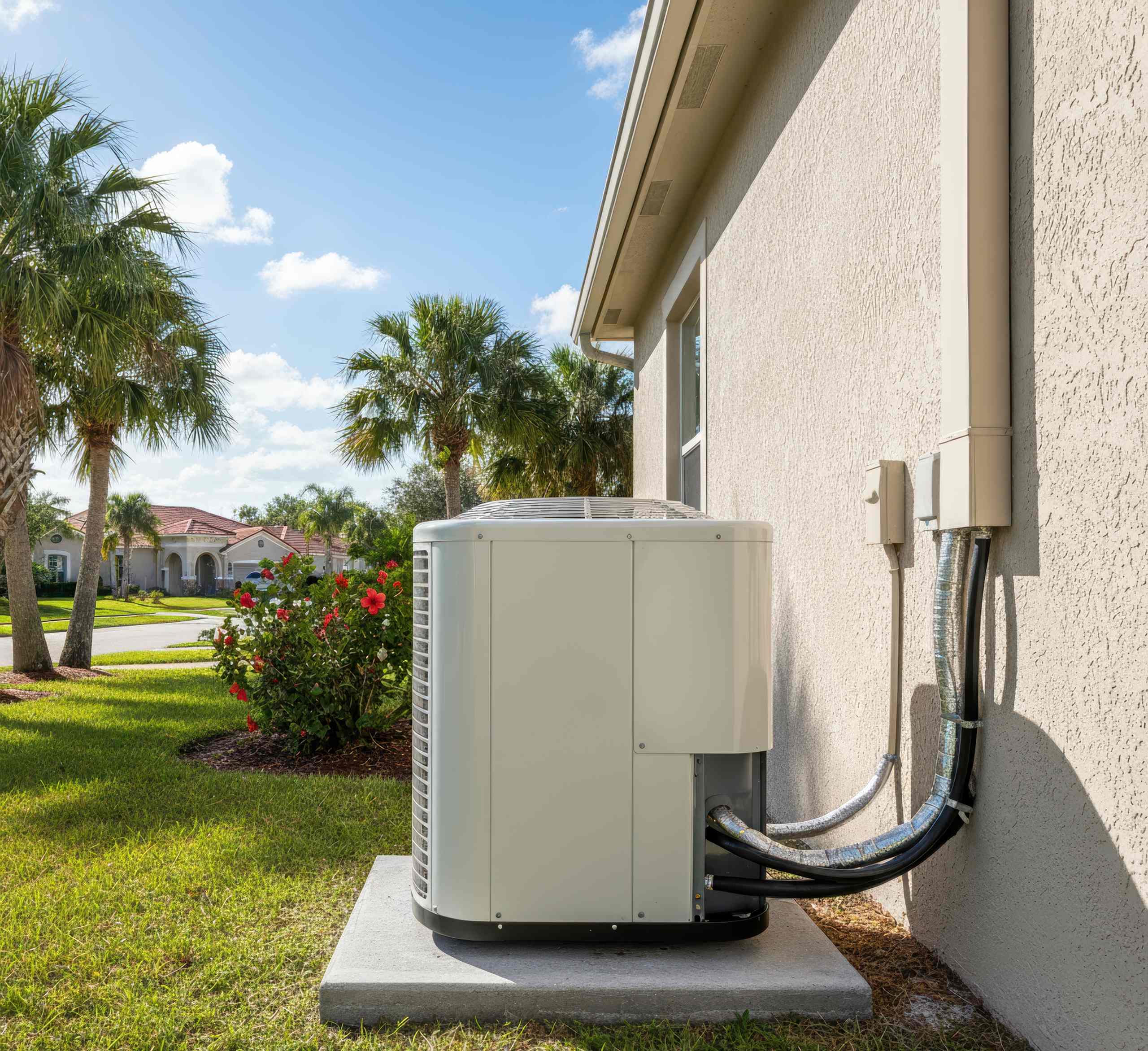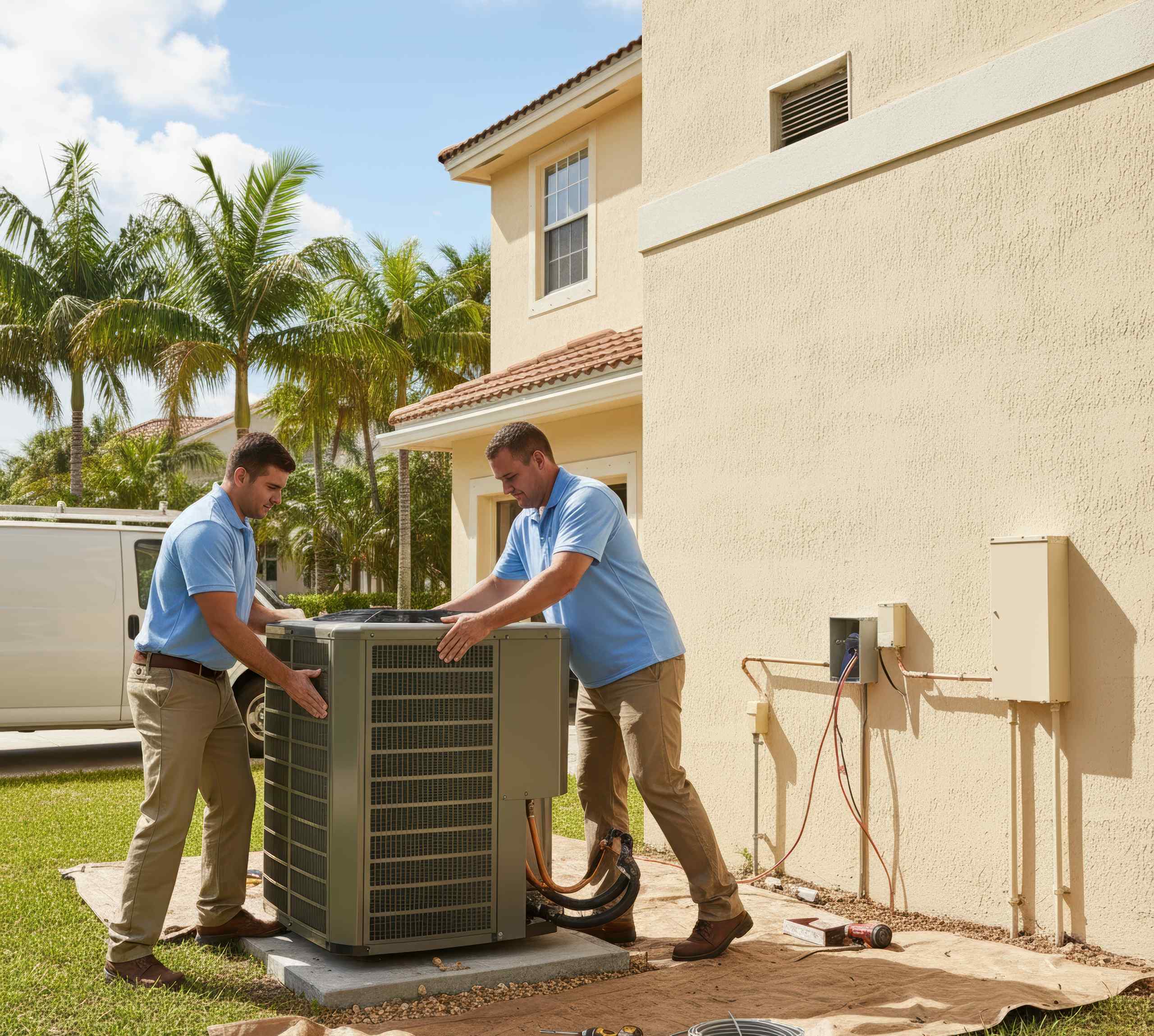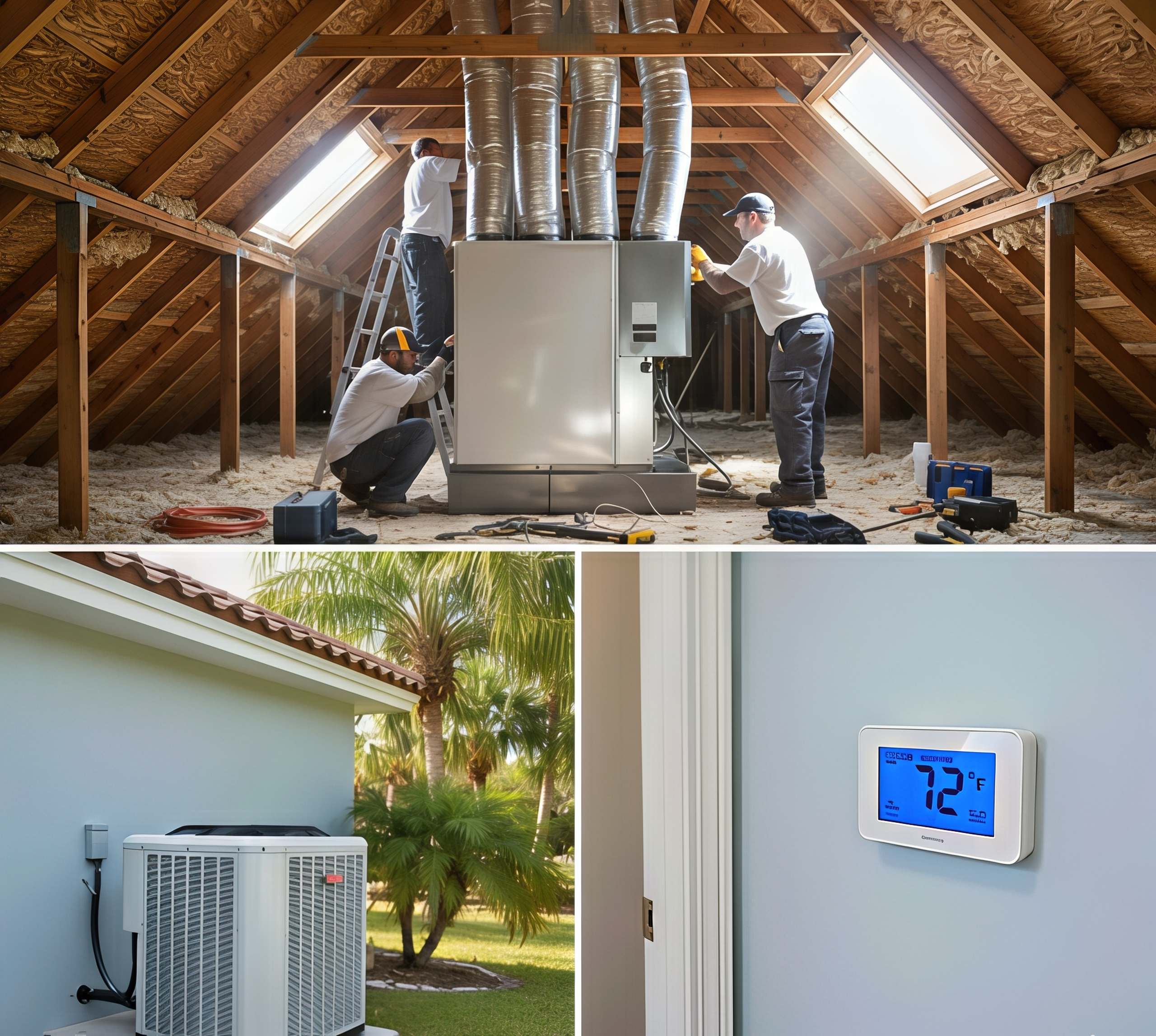As long as you choose a correctly sized air conditioner for your home, you’re all set for years to come, right?
Well, the right size air conditioner is certainly a good place to start but it’s not the only consideration when purchasing a new AC unit. The energy efficiency of the unit counts for a lot too.
The type of unit you choose affects the energy efficiency and running costs—from standard single-stage units to two-stage air conditioners and variable-speed units.
Let’s explain what two-stage conditioners are and how they can help save you money every month on electricity bills in Florida…
WHAT IS A TWO-STAGE AIR CONDITIONER?

A two-stage air conditioner has a compressor that can operate at either full speed (high-stage operation) or at around 60 to 70 percent of full capacity (low-stage operation). When mild cooling is sufficient, which is 80 percent of the time, the lower speed conserves energy, reduces monthly electricity bills, increases comfort levels, and potentially prolongs the life of the AC unit.
Let’s look at how two-stage air conditioners work, their main benefits, and what other options homeowners have when selecting AC units for their homes…
STAY COOL ALL YEAR ROUND WITH ONE WAY AIR…
The team at One Way Air installs, services, and repairs all types of air conditioning systems in Southwest Florida. Get in touch with us here for a quote or call 239-233-4356 in emergencies.
HOW TWO-STAGE AIR CONDITIONERS WORK
In a two-stage air conditioner, the AC compressor has two operating capacities:
- High-stage operation: this is where the compressor operates at the same capacity as a single-stage unit. It cools the home during peak demand when rapid cooling is required, such as when the AC is first turned on, during the hottest part of the day, and in the middle of summer.
- Low-stage operation: this is where the compressor operates at 60–70 percent capacity mode for milder cooling demands, such as mornings, evenings or during milder weather.
In two-stage air conditioners, the low-stage operation is used around 80 percent of the time, leading to greater efficiency, energy savings, humidity control, and other benefits (see below).
Say you set the thermostat to 72 degrees. Depending on the AC setup with a single-stage air conditioner, the home might get to 73 degrees before starting up, then cool the home to 72 or 71 degrees (at full capacity). Then the cycle repeats, always with the AC running at 100 percent.

With a two-stage cooling system, the unit works less intensely when the thermostat temperature is close, using less energy and preventing the need to run at full capacity so often.
Two-stage air conditioners use smart components to adjust their speeds. The system determines which stage to use based on the indoor temperature and thermostat signals.
Most systems today use scroll compressors. These have two compression chambers with internal mechanical changes and an electronic solenoid to switch stages. A system with two separate compressors is rare while variable-speed inverter compressors are sometimes used in premium systems (more about variable-speed systems below).
KEY BENEFITS OF TWO-STAGE AC UNITS
There are several key advantages of two-stage cooling over single-stage units:
ENERGY EFFICIENCY
The hot, humid climate in Florida means that we use our air conditioning more than most of the country. Even a small increase in energy efficiency can produce big rewards. With two-stage units operating at the lower-speed option for the majority of the time, they help to save energy.
COST SAVINGS
The average monthly electricity bill in Florida is $165-$170. AC is one of the major contributors to electricity bills here. Annually, Florida homeowners can expect to save 10-20 percent or more on cooling bills by switching from a single-stage AC unit to a two-stage unit.
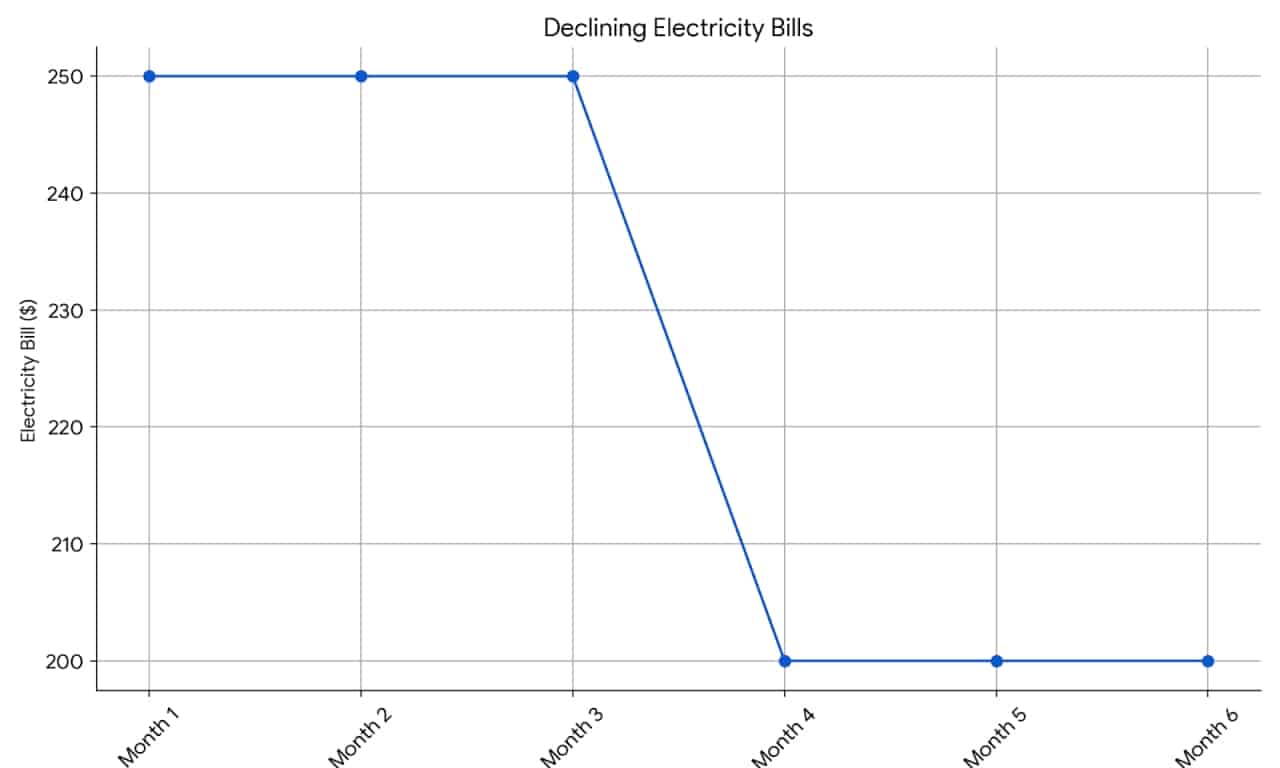
FEWER HOTSPOTS
A two-stage AC unit will deliver more consistent temperatures throughout the home, with fewer swings in temperature and fewer hot spots in rooms that should be cool. This can improve general comfort levels for everyone in the home.
BETTER HUMIDITY CONTROL
High humidity is a problem in Florida, often leading to the growth of mold and mildew in homes and a musty smell coming from the AC.
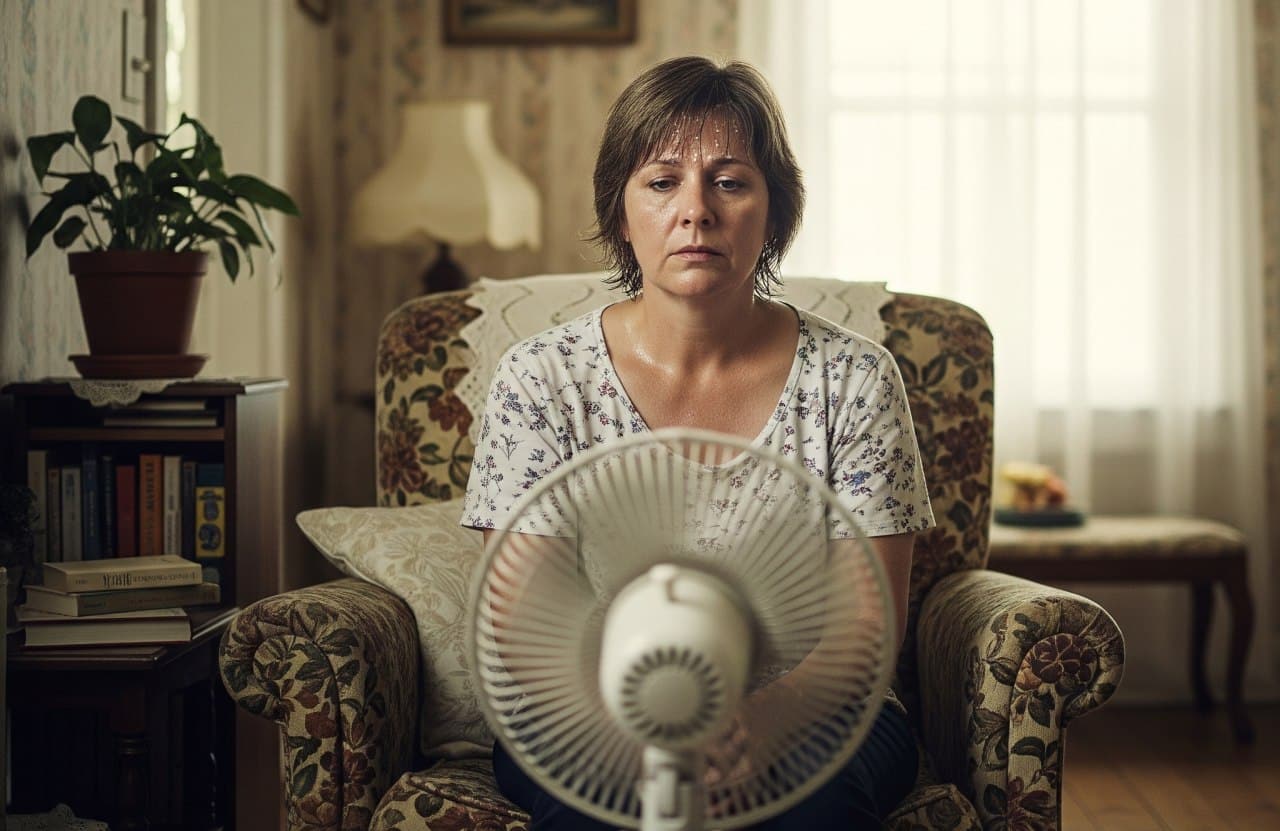
Installing a two-stage AC unit should lead to improved humidity control due to longer AC runtimes (at reduced speeds) and less on-off cycling. This keeps the evaporator coil colder for longer and ensures that more moisture is removed from the indoor air as it passes over the coil, without overcooling the home.
On average, two-stage air conditioners can remove twice as much moisture from the air as single-stage units.
BETTER AIR QUALITY
Two-stage AC units can also improve indoor air quality because they run for longer at lower speeds, helping to purify the air as it passes through the HVAC filter and removing unwanted pollen, dust, pet dander, and other unwanted contaminants from the air.
LOWER AC NOISE LEVELS
Single-stage air conditioners tend to be noisier than two-stage units because they constantly run at full speed. The two-stage unit has a “lower gear” operation that allows it to run a little more quietly than its cousin.

LONGER AC LIFESPAN
In Florida, air conditioning works so hard that it can shave a few years off the expected lifespan of AC units compared to most of the country. However, a two-stage air conditioner generally lasts longer than a single-stage AC unit because of reduced wear of components from fewer full-power cycles.
ARE THERE ANY DRAWBACKS WITH TWO-STAGE AC UNITS?
The obvious downside of two-stage cooling units over single-stage units is the higher upfront cost.
The cost of AC in Florida is significant. Some homeowners fall into the trap of buying a “deal” without assessing the ongoing running costs, which greatly affect their electricity bills. Suppliers may offer cheaper units that they are trying to move out the door as newer, more efficient, more in-demand units come onto the market. This might not be the best option for the longer term.
The costs of a two-stage AC unit can vary based on brand, size (tonnage), SEER rating, and installation complexity but, typically, you’ll pay between $2,000 and $3,000 more for a fully installed two-stage unit in Florida than a single-stage unit.
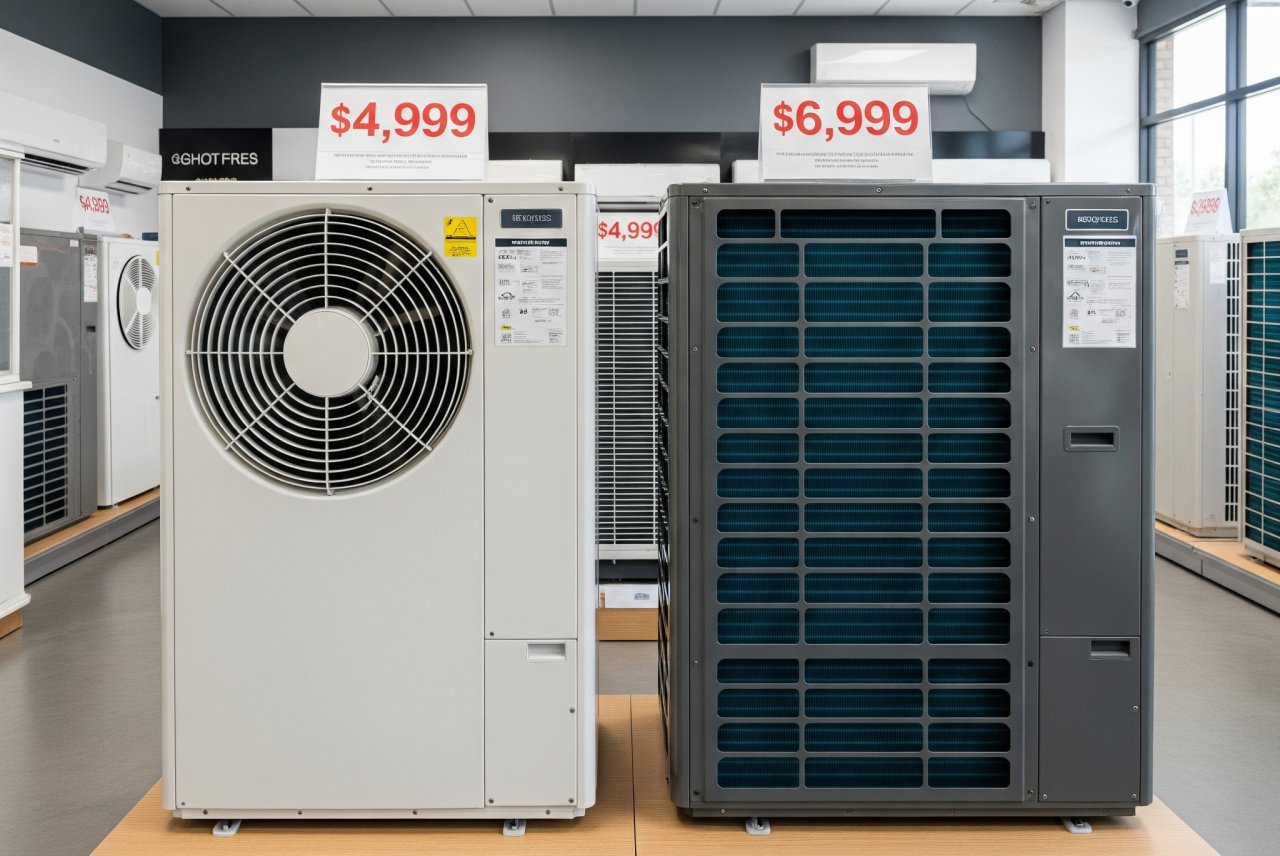
Fortunately, the return on investment (ROI) starts from the very first month with cooling bills reduced by 10-20 percent. This can amount to several hundred dollars per year, so a new AC unit can more than pay for its additional costs within 7-10 years—not to mention the other benefits.
The AC payback period is shorter if you upgrade from an old low, efficiency, one-stage AC unit to a high SEER-rating two-stage unit—saving up to 40 percent on cooling energy costs.
SINGLE-STAGE VS TWO-STAGE VS VARIABLE-SPEED AC
Did you know that there are other AC types besides single-stage and two-stage air conditioners?
Variable-speed units are the most energy-efficient air conditioners on the market in SW Florida—frequently offering SEER ratings of above 20 (compared to 13-15 for single-stage units).
These multi-stage AC units have up to 700 distinct compressor settings for different airflow levels. They offer incremental adjustments to the speed, using only the power required to maintain a consistent temperature in the home.
The downside? Again, they come at a significantly higher upfront cost than single-stage AC units. Whether they are an option for you depends on your available AC installation budget.
|
AC TYPE |
Efficiency |
Price Range (Installed) |
Main Benefits |
|---|---|---|---|
|
Single-Stage |
SEER 13-15 |
$4,500 – $6,500 |
|
|
Two-Stage |
SEER 15-18 |
$6,500 – $9,000 |
|
|
Variable Speed |
SEER 18-26+ |
$8,500 – $13,000 |
|
FAQs
A two-stage AC unit requires a multi-stage thermostat that is capable of controlling the AC system through staging logic. A professional installation will address this, with a smart thermostat likely recommended for compatibility.
You can ask your AC professionals if your installation will qualify for state programs, such as Florida Public Utilities rebates or Florida Power & Light (FPL). You can also check whether federal tax credits apply under the Inflation Reduction Act.
A two-stage AC operates around 80 percent of its run time on its lower, energy-efficient stage but switches to the high stage when needed for rapid cooling. The unit will cycle off once the temperature set on the thermostat is reached.
If your furnace is older than 15 years, it likely has a single-speed blower that may not be compatible with a two-stage air conditioning system. The blower motor within the HVAC system should be able to handle the varying stages of the cooling cycle and may require an upgrade of other equipment. Check with your HVAC professional about what you would need.
A two-stage AC unit requires the same annual maintenance as a single-stage air conditioner (filter changes, coil-cleaning, etc.) but the process may be slightly more involved. This is mainly due to the dual-speed compressor (both speeds need checking), a more complex thermostat, and a more complex control board.

CHOOSING THE RIGHT AC FOR YOUR FLORIDA HOME
Two-stage cooling provides an excellent balance between comfort and efficiency, with benefits over single-stage AC units but without the high upfront cost of variable-speed units.
The option you choose for your SW Florida home will depend on multiple factors, including your budget, the availability of rebates, your ROI expectations, how long you plan to remain in your home, your energy efficiency preferences, the existing ductwork and HVAC setup, and other factors.
For an accurate assessment of the AC unit you need and a dependable AC installation, contact an AC professional at One Way Air for an inspection today.

